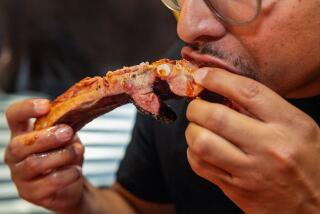Lamb sellers aim to get a leg up in U.S.
- Share via
As turkey is to Thanksgiving and roast beef to Christmas, so lamb is to Easter and Passover. It’s the best season of the year for an industry that’s been struggling to get more racks and legs on American dinner plates.
Lamb and mutton consumption in the U.S. has dropped for the last four years and is expected to be flat at best in 2012, according to the American Lamb Board.
Experts blame a sluggish economy and lamb’s high price relative to other meats. Racks of lamb were selling this week at a Whole Foods market in Los Angeles for a hefty $17.99 a pound.
Then there’s fear of the unknown. Nearly 40% of Americans have never eaten lamb, according to a 2011 survey by the American Lamb Board.
“People are not quite sure what to do with it,” said Angela Gentry, marketing director for lamb processor Superior Farms in Dixon, Calif. “The grocery industry has made it seem like a specialized product, like wild game.”
Still, the industry is hopeful that a recovering economy, changing demographics and evolving tastes can give lamb a leg up. Long popular among growing immigrant populations in the United States, lamb is starting to catch on with young, adventurous eaters who watch food television shows. An industry campaign is underway to get ranchers to increase their flocks.
“For our stores, lamb is a very good category. It’s been growing every year,” said Theo Weening, the global meat coordinator for Whole Foods Market Inc. “The cooking shows and magazines are making people feel more comfortable.”
U.S. lamb consumption peaked in the 1940s at 6.6 pounds per person, and has since fallen to a little more than a pound per person a year, according to a National Academy of Sciences report. Experts point to a variety of factors over the decades, including a shift in wool production offshore.
American sheep ranchers are aging, and too few young people are taking their place despite the potential for a profitable business, Superior Farms’ Gentry said.
Still, some lamb sellers are doing a brisk trade this spring, the time when 20% of all lamb is purchased in the U.S. Passover begins Friday evening and Easter is Sunday.
Lindy & Grundy, a boutique butcher on Fairfax Avenue, stocked 12 lambs for the week — up from the usual three or four, co-owner Erika Nakamura said. The animals come from Stemple Creek Ranch in Marin County.
Nathan McCall, the owner of McCall’s Meat and Fish Co. in Los Feliz, said he expected double his usual sales for lamb this week, with many customers choosing a leg of lamb, priced at $9.99 a pound with the bone in, or $15.99 boneless.
McCall sells lamb from California and Colorado, the nation’s second- and third-largest producers behind Texas.
Imported lamb, mostly from Australia and New Zealand, accounts for about half of U.S. consumption. But McCall said his customers’ desire for locally raised food is “more than I could ever imagine.”
“It’s all about media exposure,” he said. “People are becoming more aware.”
Marcie Jimenez, a Santa Ynez Valley farmer who sells her lamb regularly at the Santa Monica Farmers Market, agrees.
“I see a big trend toward eating local lamb, and people want to know who’s raising their food and where their food is coming from,” said Jimenez, who raises a breed of sheep known as Dorper with her husband, Gustavo. “I’ve been strongly trying to educate people about what you get. We use the whole animal. They’ll want racks or whatever they’re used to getting. There’s only two racks on a lamb. And I still have the rest of the animal.”
She expects to sell as many as 10 lambs this week, up from the usual two to three. A bone-in leg is priced at $14 a pound. Jimenez Family Farm also sells lamb shoulder, pieces for stew or kebabs, neck and ground meat.
It’s no surprise that Gentry of Superior Farms has plenty of lamb recipes at her disposal. On Easter Sunday, she said, she’ll cook a rack of lamb, seared and then roasted with Dijon mustard and bread crumbs — the recipe that, she said, made her boyfriend fall in love with her.
More to Read
Eat your way across L.A.
Get our weekly Tasting Notes newsletter for reviews, news and more.
You may occasionally receive promotional content from the Los Angeles Times.










